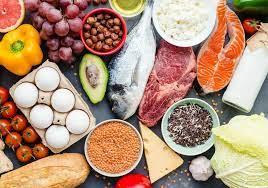Macronutrients
Introduction : Firstly, nutrition is the process of obtaining food necessary for every biological process. The food which is in taken is called nutrients . This can be obtai...

Physiology of digestion :
Digestion is the process of breaking down complex organic food substances into smaller and simpler forms so that it can be easily incorporated by our body.
Water, vitamins, and minerals are not needed to be digested but are directly absorbed.
Types of digestion :
Physical/ Mechanical digestion : size of particles get reduced without any molecular reformation . This is done by peristalsis , or the churning effect of teeth and tongue .
Chemical digestion : chemicals like enzymes are involved to get molecular changes ; mainly breaking polymers to monomers.
Physiology of it is studied under following headings :
Ingestion : this is a scientific term for eating. We humans have holozoic ingestion.
Digestion :
Digestion in mouth :
In humans both chemical and physical digestion begins in the mouth . in contrast to frogs whose digestion doesn't occur in the mouth.
Starch (about 30 %), in presence of salivary amylase/ptyalin, is converted to maltose, maltotriose and dextrose.
Lingual lipase is in the mouth but as it requires an acidic medium, no digestion occurs due to it. Rather it goes down to the stomach with the bolus of food.
Digestion in the stomach :
Hcl converts pepsinogen/inactive to pepsin and pro-rennin to rennin (in case of babies).
Then ,in baby rennin changes casein/milk protein to paracasein .
Eventually , pepsin changes protein of about 20% to peptides . And in babies it changes paracasein to peptides.
Lipids are changed to fatty acids and glycerol by activated salivary lipase or gastric lipase which is only in babies . Thus, lipase digestion in the stomach seems insignificant, being only around 10 %.
Digestion in small intestine :
In duodenum:
Here, bile and pancreatic juice acts upon the chyme.
(chyme is the result of digestion in the stomach)
Pancreatic juice is also called complete digestive juice as it possesses all 3 enzymes to digest all 3 macronutrients.
Amylase, in the duodenum, converts remaining starch to its monomers.
Pancreatic lipase converts most of the lipid to fatty acid and glycerol. Before this, bile juice comes in to emulsify and coat the last product from fats due to lipase.
Trypsin , chymotrypsin and carboxypeptidase digest remaining protein into smaller peptides and amino acids .
Ribonuclease and deoxyribonuclease convert RNA and DNA to respective nucleotides.
In jejunum absorption occurs more than digestion.
Digestion in ileum .
All the intestinal juices are termed as succus entericus which act in ileum.
Aminopeptidase and dipeptidase finally act upon peptides and convert them to aminoacids .
Maltase converts maltose into glucose .
Sucrase converts sucrose into glucose and fructose .
Lactase act upon lactose to break them into galactose and glucose .
Trehalase converts trehalose to glucose .
Alpha dextrinase converts dextrin to glucose .
No digestion occurs in anus and large intestine.
For sake of simplicity, we can learn the physiology from the below table (they can be shown in reaction form according to your convenience).

Absorption :
The process by which simplified foods are incorporated into blood vessels or lacteals for using or storing them as per needs. It can be actively using ATP or passively with respect to osmotic gradients.
1.Starts from the mouth : certain drugs and water get absorbed here.
2. Absorption in stomach :
Water and Alcohol is readily absorbed from here. so we get intoxicated by alcohol fastly.
3. Absorption in intestine :
Duodenal absorption :
Calcium , iron and vitamin C are the prominent ones to be absorbed from here.
In general, absorption occurs in the intestine.
Absorption of carbohydrates :
Glucose, galactose are absorbed to the luminal surface by secondary active transport, i.e., by the indirect use of ATP.
Fructose are absorbed by luminal surface by facilitated diffusion .
While , everything in the luminal surface is absorbed to blood vessels’ basal membrane by facilitated diffusion .
Absorption of fats :
When bile acids coats digested fats, it is called micelles. Now leaving, coated layer , inner content enters enterocytes. Now, inside enterocytes, they combine with apoprotein to form lipo proteins of 4 -5 types, of which chylomicrons are the least dense.
Chylomicrons as being most permeable to lacteals enter and then combine with lymphs to form chyle and then enter to blood.
Lacteals are mostly found in jejunum so it’s clear that fat absorption is mostly there.
Absorption of proteins :
They are absorbed in the form of amino acids or di peptides .
Free amino acids are absorbed by sodium dependent diffusion while dipeptides by hydrogen dependent active transport . which later cleaved and again absorbed by facilitated diffusion.
Little water and electrolytes are absorbed here too.
4. Absorption in large intestine :
Here only water and electrolytes are absorbed through osmosis.
Egestion :
This is the final step where undigested and unabsorbed foods are ejected out .
For concepts you can even go though this video :